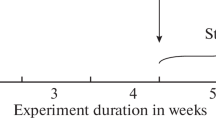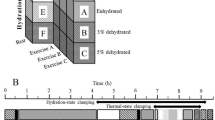Abstract
In separate experiments dogs and men were exposed to various combinations of dry-bulb (DB) and wet-bulb (WB) temperatures (DB 37.8 to 54.4°C, WB 23.9 to 47.2°C). Rectal temperature (Tr), tolerance time (TT) and incidence of tetany were noted. In some experiments total plasma catecholamines and blood(venous or arterial) pH and\(P_{CO_2 } \) were also measured. Dogs were removed from the heat when Tr reached 42.0°C and men were removed when Tr reached 39.2°C or for other reasons.Dog and man, when exposed to particular environmental conditions, hyperventilate to the extent that, in man blood CO2 and pH approximate 20 mm Hg and 7.6 respectively and, in the dog 10 mm Hg and 7.7 respectively. When the heat load is very high,both dog and man hyperventilate earlier and the changes in blood pH and CO2 are more rapid. However, whereas man experiences intense carpopedal spasm, the dog does not, even though the changes in pH and CO2 are greater in the dog. There was no significant change in plasma catecholamines during heat stress.
Zusammenfassung
In verschiedenen Experimenten wurden Hunde und junge Männer Hitze von verschiedener Trocken- und Feuchttemperatur (TT 37, 8-54, 4°C, FT 23,9-47, 2°C) exponiert und die Rektaltemperatur (Tr),Toleranzzeit (TT) und Tetaniehäufigkeit gemessen. In einigen Experimenten wurden zusätzlich die PlasmaKatecholamine, Blut pH und\(P_{CO_2 } \) (arteriell und venös) bestimmt.Die Exponierung wurde unterbrochen,wenn bei Hunden die Tr 42,0°C und bei Männern 39,2°C erreicht hatte. Hunde und Männer hyperventilieren unter den Hitzebedingungen in solchem Ausmass, dass sich beim Hund Blut\(P_{CO_2 } \) 10 mm Hg und pH 7,7 nähern, beim Mann 20 mm Hg und pH 7,6.Bei sehr starker Hitzebelastung erfolgt bei beiden die Hyperventilation früher und die Blut-Veränderungen erscheinen früher.Beim Menschen tritt ausserdem Carpopedalspasmus auf,nicht beim Hund, obwohl die Blut pH und CO2 Veränderungen extremer sind.Die Plasmakatecholamine waren während der Hitzebelastung nicht signifikant verändert.
Resume
On a exposé séparément des chiens et des êtres humains à différentes combinaisons de températures sèche (TS) et du thermomètre mouillé (TM) (TS de 37,8 à 54,4°C, TM de 23,9 à 47,2°C). On a noté dans chaque cas la température rectale(Tr) et le temps de tolérance (TT) ainsi que l'incidence des conditions ambiantes sur la tétanie. Dans quelques cas, on a en outre déterminé la catécholamine plasmatique totale ainsi que le pH et la\(P_{CO_2 } \) du sang aussi bien artériel que veineux.On a interrompu l'expérience lorsque Tr a atteint 42,0°C chez le chien et 39,2°C chez l'homme. La respirations augmente sous l'effet de la chaleur et cela aussi bien chez le chien que chez l'homme si bien que, pour le premier,\(P_{CO_2 } \) atteint 10 mm Hg et pH 7,7,respectivement 20 mm Hg et 7,6 pour le second. Si la charge due à la chaleur est très élevée, l'augmentation de la vitesse de respiration et les modifications sanguines se manifestent plus rapidement. On constate en outre chez l'homme des spasmes carpopédaliques, ce qui ne se produit pas chez le chien bien que les modifications du pH et du CO2 soient plus marquées dans le second cas que dans le premier. On discute enfin les répercussions futures de ces résultats ainsi que d'autres.
Similar content being viewed by others
References
ADOLPH, E.F. (1924): The effects of exposure to high temperatures. Amer. J. Physiol., 67: 573–588.
BROWN, E.B. (1953): Physiological effects of hyperventilation. Physiol.Rev., 33: 445–471.
ELMADJIAN, F., HOPE, J.M. and LAMSON, E.T. (1958): Excretion of epinephrine and norepinephrine under stress. Rec.Prog.Hormone Res., 14: 513–553.
FERRO, P.V. and HAM, A.B. (1957): A simple spectrophotometric method for the determination of calcium. Amer.J.clin.Pathol., 28: 689–693.
FIORICA, V., IAMPIETRO, P.F., HIGGINS, E.A. and MOSES, R. (in press): Sympathicoadrenomedullary (SAM) activity in dogs during acute heat exposure. J.appl.Physiol.
FIORICA, V. (1965): An improved semi-automated procedure for fluorometric determination of plasma catecholamines. Clin.chim.Acta., 12: 191–197.
GOLDMAN, R.F., GREEN, E.B. and IAMPIETRO, P.F. (1965): Tolerance of hot, wet environments by resting men. J.appl.Physiol., 20: 271–277.
GRANT, S.B. and GOLDMAN, A. (1920): A study of forced respiration:experimental production of tetany. Amer.J.Physiol., 52: 209–232.
HIGGINS, E.A. and IAMPIETRO, P.F. (in press): Thermal panting and the initiation of respiratory alkalosis. Canad.J.Physiol.Pharmacol.
HILL, J.B. (1965): An automated fluorometric method for determination of calcium. Clin.Chem., 11: 122–130.
IAMPIETRO, P.F. and GOLDMAN, R.F. (1965): Tolerance of men working in hot,humid environments. J.appl.Physiol., 20: 73–76.
IAMPIETRO, P.F., MAGER, M. and GREEN, E.B. (1961): Some physiological changes accompanying tetany induced by exposure to hot, wet conditions. J.appl.Physiol., 16: 409–412.
KANTER, G.S. (1954): Effect of heat on regulation of body fluids and electrolytes in dogs. Amer.J.Physiol., 178: 259–262.
KOEHLER, A.E. (1923): Acid-base equilibrium. I. Clinical studies in alkalosis. Arch.Int.Med., 31: 590–605.
LANDIS, E.M., LONG, W.W., DUNN, J.W., JACKSON, C.L. and MEYER, U. (1926):Studies on the effects of baths on man. III.Effects of hot baths on respiration, blood and urine. Amer.J.Physiol., 76:35–48.
LEITNER, M.J. and THALER, S. (1960): A table for calculation of arterial PCO2 from blood pH and CO2 content. Amer.J.clin.Pathol.,33:362–363.
NAHAS, G.G., JORDAN, E.C. and J.C.LIGOU (1959): Effects of a "CO2 buffer" on hypercapnia of apneic oxygenation. Amer.J.Physiol., 197:1308–1316.
NAHAS, G.G., LIGOU, J.C. and MEHLMAN, B. (1960): Effects of pH changes on O2 uptake and plasma catecholamine levels in the dog. Amer.J.Physiol., 198: 60–66.
SHOCK, N.W. and HASTINGS, A.B. (1935): Characterization and interpretation of displacement of the acid-base balance of the blood. J.biol. Chem., 112: 234–262.
SIGGARD ANDERSEN, O. (1962): The pH-log\(P_{CO_2 } \) blood acid-base monogram revised.Scand. J.clin.Lab.Invest., 14: 598–604.
SIGGARD ANDERSEN, O., JØRGENSEN, K. and ASTRUP, P. (1960): A micromethod for determination of blood pH, carbon dioxide tension,base excess and standard bicarbonate in capillary blood.Scand.J.clin. Lab.Invest., 12: 172–176.
VON EULER, V.S. (1964): Quantitation of stress by catecholamine analysis. Clin. Pharmacol.Ther., 5: 398–404.
Author information
Authors and Affiliations
Rights and permissions
About this article
Cite this article
Iampietro, P.F., Fiorica, V., Higgins, E.A. et al. Exposure to heat: Comparison of responses of dog and man. Int J Biometeorol 10, 175–185 (1966). https://doi.org/10.1007/BF01426864
Issue Date:
DOI: https://doi.org/10.1007/BF01426864




